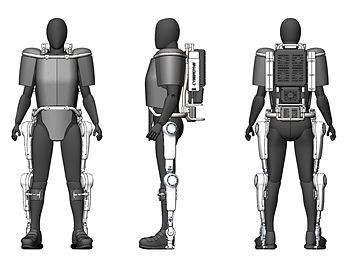Cyberdyne Unveils Improved Robotsuit HAL
Japan-based Cyberdyne unveiled a new, radiation-protected version of its exoskeleton HAL, which is designed to be used for workers at the Fukushima nuclear power plant.
Both the names Cyberdyne and HAL may not be the best names to imply a positive omen for the robotic suit, given the connotation to the Terminator and 2001: A Space Odyssey movies, but the manufacturer says that its improved Hybrid Assistive Limb suit is an ideal fit to provide a human cyborg-type robot assist that can be essential in an environment such as the severely damaged Fukushima plant.
From Cyberdyne's product description:
"When a person attempts to move, nerve signals are sent from the brain to the muscles via motoneurons, moving the musculoskeletal system as a consequence. At this moment, very weak biosignals can be detected on the surface of the skin. "HAL" catches these signals through a sensor attached on the skin of the wearer. Based on the signals obtained, the power unit is controlled to move the joint in unison with the wearer's muscle movement, enabling HAL to support the wearer's daily activities. […] Not only a 'voluntary control system' "HAL" [also] has a 'robotic autonomous control system' that provides human-like movement based on a robotic system which integrally work together with the 'autonomous control system'. "HAL" is the world's first cyborg-type robot controlled by this unique Hybrid System."
The new version of HAL was shown at the Japan Robot Week 2012. In addition to the previous power units and exo-limbs, the new version is equipped with a 132-pound vest made out of tungsten to protect workers from radioactive radiation. Since the vest is largely supported by the powered units of HAL, Cybedyne says it has virtually no effect on the wearing person. There is also a ventilation system that prevents overheating and keeps a worker cool inside the suit.
Contact Us for News Tips, Corrections and Feedback
Get Tom's Hardware's best news and in-depth reviews, straight to your inbox.

Wolfgang Gruener is an experienced professional in digital strategy and content, specializing in web strategy, content architecture, user experience, and applying AI in content operations within the insurtech industry. His previous roles include Director, Digital Strategy and Content Experience at American Eagle, Managing Editor at TG Daily, and contributing to publications like Tom's Guide and Tom's Hardware.
-
cscott_it Not to pick at you Wolfgang, but radioactive radiation made me a chuckle a bit.Reply
(You could have said dangerous or lethal instead, as I know that there are several forms of radiation, Cellular signal for example is carried on one such type).
Good humored jostle aside, interesting read. Going to have to do some research into this whole business.
Edited for clarification and to fix typo with Wolfgang -
A Bad Day I though lead and hydrogen were the best protective agents against radiation?Reply
(There's a type of radiation that is commonly found in in the outer space and easily stopped by hydrogen, though lead would only amplify it) -
jkflipflop98 I wonder how they power this badboy. Having to be tethered to a power cable would kind of destroy the whole mobility thing. . . and there's no batteries with enough capacity to keep this thing lifting heavy objects for hours on end while still being small enough to be mounted to the suit.Reply
T-51b's got around this problem by way of Microfusion cells. Too bad we don't have those. -
freggo dudemcduderson"Radioactive radiation" I did know there was any other kind!Reply
Thermal radiation...
-
thefizzle656 amuffinWhen I think Cyberdyne, I think Terminator. Should we be scared?Reply
Judgement day is upon us!!!!! -
ltdementhial i dont know how to post pictures but as many of you:Reply
http://4.bp.blogspot.com/-_J26m2shvCA/TVocAhWbS1I/AAAAAAAAAFU/j7Oox0i6q1U/s1600/Cyberdyne_systems234154.jpg -
A Bad Day amuffinWhen I think Cyberdyne, I think Terminator. Should we be scared?Reply
We wouldn't have the funding or the technology for Skynet in the first place. NASA gets about an annual $19 billion budget, US military spends about $20 billion on air conditioning (Afghanistan, etc) annually.
We're a welfare-warfare country.
